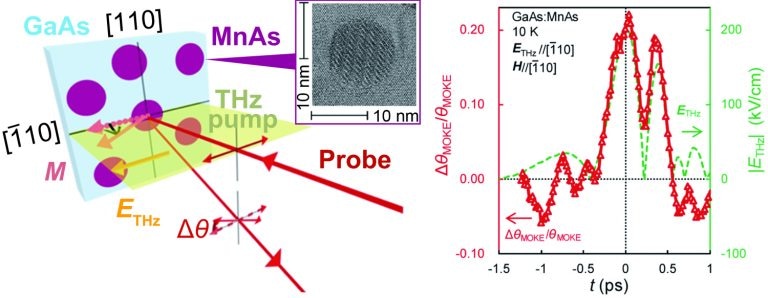Mar 29 2019
Ultrahigh-speed spintronics will soon need ultrafast coherent magnetization reversal within a picosecond, one-trillionth of a second. Spintronics focuses on the magnetic moment and spin of an electron in solid-state devices.
 A terahertz pump pulse is focused on the surface of a semiconductor sample embedded with ferromagnetic nanoparticles, and a probe pulse detects the “excited” dynamics. A large modulation of up to 20% of the magnetization was observed with terahertz pump pulse irradiation. (Image credit: Ohya Laboratory)
A terahertz pump pulse is focused on the surface of a semiconductor sample embedded with ferromagnetic nanoparticles, and a probe pulse detects the “excited” dynamics. A large modulation of up to 20% of the magnetization was observed with terahertz pump pulse irradiation. (Image credit: Ohya Laboratory)
Although this may finally be realized through irradiation with an almost monocyclic terahertz pulse, the minor change of magnetization or modulation caused by it has prevented any practical application of this technique until now.
Usually, the “magnetic field” component of a terahertz pulse is regarded as the source of the coherent terahertz response of the magnetization. However, as earlier identified by a team of University of Tokyo scientists, the “electric field” component of a terahertz pulse plays a vital role in the terahertz magnetization modulation of semiconductor-based ferromagnetic materials.
Recently, the researchers have described in the journal Applied Physics Letters, from AIP Publishing, that their first discovery motivated them to investigate ferromagnetic nanoparticles embedded within a semiconductor. Their theory was that the electric field of the terahertz pulse could be successfully applied to each nanoparticle because of the small energy loss of the terahertz pulse during its propagation through a semiconductor.
Until now, ferromagnetic metal films have been used for studies on the terahertz modulation of the magnetization. The modulation ratio reported so far has typically been less than ~1 percent of the saturation magnetization.
Shinobu Ohya, Associate Professor, University of Tokyo
To verify their theory, the team used a semiconductor gallium arsenide (GaAs) film which has a thickness of 100 nm embedded with ferromagnetic manganese arsenide (MnAs) nanoparticles.
“The small energy loss of the terahertz pulse during the propagation in our film allows it to penetrate the film. This means that the strong terahertz electric field—with a maximum intensity of 200 kilovolts/centimeter—is uniformly applied to all of the ferromagnetic nanoparticles,” stated Ohya. “This strong electric field induces the large magnetization modulation via the modulation of the carrier density in the MnAs nanoparticles, thanks to the spin-orbit interaction.”
The scientists were successful in achieving a large modulation of around 20% of the saturation magnetization and also inferred that the electric field component of the terahertz pulse plays a vital role in the large modulation.
Our results will lead to an ultrafast coherent magnetization reversal within a picosecond, which will be an essential technique for ultrahigh-speed spintronics. Ferromagnetic nanoparticle systems are extremely promising for high-speed magnetization switching using terahertz pulses.
Shinobu Ohya, Associate Professor, University of Tokyo